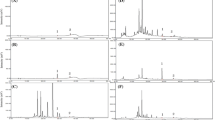Summary
The determination of diacetyl, 2.3-pentanedione and acetoin was performed in two steps. Diacetyl and 2.3-pentanedione were driven off with gaseous nitrogen at 60° C and collected in ice cooled methanol. The quantitative gaschromatographical determination follows after directly injecting this solution into the gas chromatograph employing an electron capture detector which indicates selectively the vicinale diketones. In a second experiment acetoin was determined by a differential method after oxidizing acetoin to diacetyl.
The investigation of 57 German white wines of various vintages, varieties and quality classes yielded the following results: Diacetyl: Limits of variability (V) = 0.08–3.40 mg/l, average amount (M) = 0.42 mg/l; 2.3-pentanedione:V = 0.02–0.36 mg/l,M = 0.10 mg/l; Acetoin:V = 1.9–31.7 mg/l,M = 5.9 mg/l. No differences could be observed with regard to the various quality classes. In 20 red vines of various European origines the following amounts were observed: Diacetyl:V = 0.26–4.06 mg/l,M = 1.46 mg/l; 2.3-pentanedione:V = 0.08–0.88 mg/l,M = 0.25 mg/l; Acetoin:V = 5.9–38.2 mg/l,M = 15.0 mg/l. For a rule the red wines show considerable higher contents of diacetyl, 2.3-pentanedione and acetoin than the white wines.
Zusammenfassung
Die Bestimmung von Diacetyl, 2,3-Pentandion und Acetoin erfolgt in zwei Schritten. Diacetyl und 2,3-Pentandion werden aus der Untersuchungsprobe im Stickstoffstrom bei 60° C ausgetrieben und in einer eisgekühlten Vorlage in Methanol aufgefangen. Die quantitative gaschromatographische Bestimmung erfolgt nach Direktinjektion dieser Lösung unter Verwendung eines Elektroneneinfangdetektors, der die vicinalen Diketone selektiv anzeigt. In einer weiteren Probe wird Acetoin nach Oxydation zu Diacetyl im Differenzverfahren bestimmt.
Die Untersuchung von 57 deutschen Weißweinen verschiedener Jahrgänge, Sorten und Qualitätsstufen führte zu folgenden Ergebnissen: Diacetyl: Variationsbreite (V) = 0,08–3,40 mg/l, Durchschnittswert (M) = 0,42 mg/l; 2,3-Pentandion:V = 0,02–0,36 mg/l,M = 0,l0mg/l; Acetoin:V = 1,9–31,7 mg/l,M = 5,9 mg/l. Zwischen den verschiedenen Qualitätsstufen ließen sich keine Unterschiede erkennen. Bei 20 Rotweinen verschiedener europäischer Herkünfte ergeben sich folgende Werte: Diacetyl:V = 0,26–4,06 mg/l,M = 1,46 mg/l; 2,3-Pentandion:V = 0,08–0,88 mg/l,M = 0,25 mg/l; Acetoin:V = 5,9-38,2 mg/l,M = 15,0 mg/l. Die Rotweine besitzen in der Regel erheblich höhere Gehalte an Diacetyl, 2,3-Pentandion und Acetoin als die Weißweine.
Similar content being viewed by others
Literatur
Scherrer, A.: Schweiz. Brau. Rdsch.82, 21 (1971)
Wainwright, T.: J. Inst. Brew.79, 451 (1973)
Miedaner, H., Narziß, L., Wörner, G.: Brauwiss.27, 212 (1974)
Kielhöfer, E., Wüirdig, G.: Weinwiss.15, 135 (1960)
Ronkainen, P., Suomalainen, H.: Mitt. Klosterneuburg19, 102 (1969)
Koch, J., Hess., D., Gruss, R.: Z. Lebensm.-Unters.-Forsch.146, 143 (1971)
Radler, F.: Vitis3, 136 (1962)
Dittrich, H. H., Kerner, E.: Weinwiss.19, 528 (1964)
Mändl, B., Geiger, E., Piendl, A.: Brauwissenschaft27, 57 (1974)
West, D. B., Lautenbach, A.L., Becker, K.: Am. Sec. Brewing Chemists Proc.1952, 81
Owades, J.L., Jakovac, J.: Am. Soc. Brewing Chemists Proc.1963, 22
Canales, J. M., Martinez, N.: Amer. Brewer95, 10 (1962)
Owades, J.L., Jakovac, J., Vigilante, C.: Am. Soc. Brewing Chemists, Proc.1960, 63
Brenner, M. W., Blick, S.R., Frenkel, C., Siebenberg, J.: Proc. EBC-Congr.1963, 233
Gjertsen, P., Undstrup, S., Trolle, B.: Mschr. Brauerei17, 232 (1964)
Kato, S., Nishikawa, M.: Bull. Brew. Sci.6, 12 (1960)
Prill, E. A., Hammer, B. W.: Iow. St. Coll. J. Sci.12, 385 (1938)
Drews, B., Specht, H., Bärwald, G., Trénel, G.: Mschr. Brauerei19, 34 (1966)
Kielhöfer, E., Würdig, G.: Wein Wiss.15, 135 (1960)
Drews, B., Specht, H., Trénel, G.: Mschr. Brauerei20, 149 (1967)
Harrison, G. A. F., Byrne, W. J., Collins, E.: J. Inst. Brew.71, 336 (1965)
Drews, B., Bärwald, G., Niefind, H.J.: Mschr. Brauerei21, 96 (1968)
Inoue, T., Yamamoto, Y.: Rept. Res. Lab. Kirin Brewery13, 79 (1970)
Inoue, T., Yamamoto, Y.: Rept. Res. Lab. Kirin Brewery13, 89 (1970)
Inoue, T., Yamamoto, Y.: Rept. Res. Lab. Kirin Brewery14, 55 (1971)
Steffen, P.: Nahrung13, 697 (1968)
Haukeli, A. D., Lie, S.: Mitt. Versuchsst. Gärungsgewerbe Inst. Angew. Miterobiol.2, 22 (1972)
Author information
Authors and Affiliations
Rights and permissions
About this article
Cite this article
Postel, W., Güvenc, U. Gaschromatographische Bestimmung von Diacetyl, Acetoin und 2,3-Pentandion in Wein. Z Lebensm Unters Forch 161, 35–44 (1976). https://doi.org/10.1007/BF01145418
Received:
Issue Date:
DOI: https://doi.org/10.1007/BF01145418




